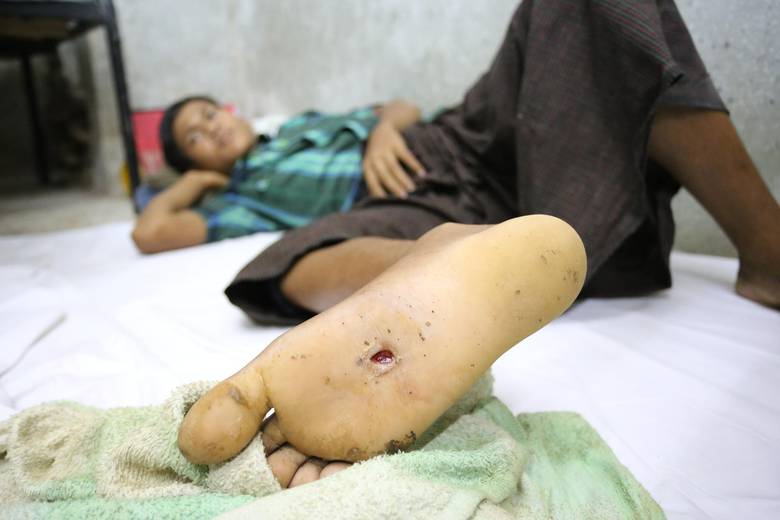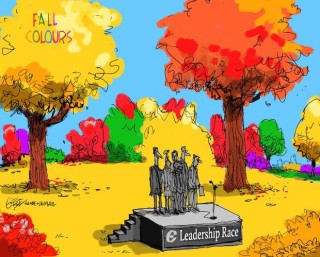As the exodus from Myanmar continues, Nathan VanderKlippe details the harrowing accounts of some of the 370,000 who have managed to flee the country.
The 13-month-old baby was blistered with burns after soldiers set on fire the house where he was napping. The 12-year-old boy was shot while he ran, his foot pierced through by a bullet. The 24-year-old father’s body became so weakened from seven days of hiding in the jungle without food that he could no longer walk. And the 75-year-old grandfather was thrown to the ground and knocked out by a land mine that exploded just a few metres in front of him.
For more than two weeks, a tide of desperation and fear has crossed into Bangladesh, as 370,000 Muslim Rohingya from Myanmar have fled homes caught up in a horrifying convulsion of violence.
Many, however, weren’t able to walk out themselves. They were carried, some over great distances by relatives who brought them to safety from what one Bangladeshi leader has called a “genocide,” human-rights activists have termed “crimes against humanity” and the United Nations secretary-general has labelled a “humanitarian catastrophe” – one that continues to unfold in Myanmar’s Rakhine state.
Now, in the cramped wards of the District Sadar Hospital in Cox’s Bazar, Bangladesh, they lie with intravenous drips and burn dressings, hoping they can physically recover from a hellish ordeal they barely escaped.
Their accounts are impossible to verify, since Myanmar has closed their home areas off to independent reporting. But their damaged bodies give vivid testimony to what they have endured.
The Rohingya’s injuries add evidence to calls on Tuesday from Human Rights Watch and Amnesty International for the United Nations Security Council to demand an end to the “ethnic cleansing” on a large scale.
Mohammad Hossen, 75, was nearly out of Myanmar when police and border guards gave chase, pushing him and a group of about 200 others to run into a channel between barbed wire fences, at a spot near the boundary between the two countries.
Two people running in front of him stepped on a land mine, scarcely four arms lengths away. They died in the blast, which sent Mr. Hossen crashing to the ground. The force rendered him unconscious.
“We didn’t know the mine was there, but the police knew,” the rice farmer told The Globe and Mail on Tuesday.
Days before he crossed into Bangladesh, Myanmar military officers had surrounded his small farming village of Zulla Hali and opened fire, from the ground and from a helicopter overhead, Mr. Hossen recalled. Grenades killed two of his grandsons, aged 5 and 7.
When the Rohingya began to run, about 200 local Buddhists began to hack at them with long machete-like knives, he said, killing babies and slashing at pregnant women who had no weapons to fight back.
“The military started firing and, when people started running, the Buddhists started chopping,” he said.
Tensions and violence between local Buddhists and Muslim Rohingya, who are largely denied citizenship in Myanmar, date back decades. Myanmar has said its military is acting to suppress a Rohingya-backed terrorist insurgency that attacked two dozen police and military outposts in late August.
The ensuing violence, and the flood of people it has unleashed, has again made the Rohingya a subject of global attention, and cast a critical new light on Myanmar under the leadership of Aung San Suu Kyi. Critics have called for the Nobel winner to be stripped of her peace prize and honorary Canadian citizenship, although defenders say the Myanmar political structure gives her little power to halt a campaign by a military with great latitude to act on its own.
For Mr. Hossen, that campaign felt like an attempt to drive his people out.
As he and his neighbours escaped, they could hear their attackers yelling. “Get out of Myanmar. Leave our place,” they jeered. “Why are you farming this land? It’s not your land.”
When the military arrived in Boli Bazar, 24-year-old cattle herder Jamal Hossen had just come home for breakfast. He ran when soldiers began shooting at his house. He crashed through jungle until, about five kilometres away, he found a small depression beside a tree where he could hide behind brush.
For 24 hours, he sat listening to the sound of gunfire. A married man with a daughter, he stayed concealed beside the tree for seven days, plunged in fear and not eating.
“I was thinking, how will I ever survive? What will I do without my family or my parents?” he said. By the time local villagers found him, he was too weak to walk. Two brothers carried him for three days, across multiple rivers, to reach the border with Bangladesh.
In Tami, another Myanmar village, Khurshida Begum was at her home when the military lit it on fire. She raced out with her husband, three daughters and two sons as flames engulfed the straw structure. In the panic, they left behind their 13-month-old son, Hares, who had been sleeping. By the time her husband returned, he had been scorched.
Ms. Begum, 30, wrapped him in cloth and tied him across her breast as she and her family began their flight to Bangladesh. They walked for four days.
“I thought he was already dead because he was not taking milk, he had a high fever and his eyes were constantly shut,” she said.
Somehow, Ms. Begum was able to deliver her son alive to Room 222, a children’s ward at the Cox’s Bazar hospital, where he lay Tuesday night on a hospital bed, the whites of his eyes blankly visible under half-open lids. The sheet that covered his motionless body was stained by the places where the burns had wept.
“I feel like he’s a little bit better,” Ms. Begum said. “He now opens his eyes a bit.”
Even for the medical staff of a busy public institution, what happened to Hares is hard to process. “If you see him, you will cry,” said Samson Naher, 25, a senior staff nurse who worked a late shift on Tuesday without pay to care for Rohingya injured with gunshots, burns and slash wounds.
She, too, has wept over his plight. “It’s terrible – when he sees us, he gets so much fear. He thinks we will all kill him.”
But Hares is not the only one in Room 222 who had to be lifted out of Myanmar. In the bed next to his, Abdur Rahim, 12, lifts a sheet to show his right foot, where a bullet hole is clearly visible, extending from the sole to the ankle.
The military shot him as he ran away, but he was so overwhelmed by fear that he only noticed the blood when he stopped for water. His father then carried him to Bangladesh.

Abdur Rahim, 12, was shot by soldiers as he ran away from violence in Myanmar. NATHAN VANDERKLIPPE/THE GLOBE AND MAIL
But even those able walk out of Myanmar themselves brought with them heavy burdens.
Khaleda Begum sought refuge in her house when the military opened fire, only to have soldiers kick open the door and take two of her sons, 16 and 20.
“Whoever they could grab, they chased them and took away to be killed,” she said. Soldiers grabbed earrings and other valuables from women, she said, and “whoever looked good, they raped in front of everyone.”
When the 55-year-old mother was able to flee, she passed by a woman lying naked in the street, blood pooling around her from a violent sexual assault.
Neighbours later told her both of her sons had died. They identified the bodies by their clothes. The young men had been beheaded.
Tears streaked Ms. Begum’s face as she spoke in Room 222 beside her six-year-old grandson, Faisal, who broke his arm when he fell during their escape.
“I will not go to Burma again,” she said, using the former name for Myanmar.
“If you guys want to kill us, just kill us here. I won’t go back to Burma again.”
NATHAN VANDERKLIPPE
Asia Correspondent
The Globe and Mail, September 13, 2017

